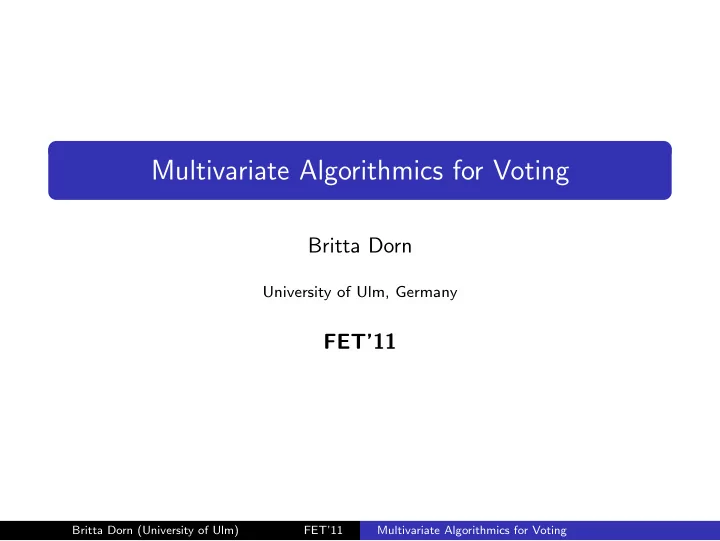

Multivariate Algorithmics for Voting Britta Dorn University of Ulm, Germany FET’11 Britta Dorn (University of Ulm) FET’11 Multivariate Algorithmics for Voting
Voting systems Multiple parties, different preferences → joint decision Political elections Group decisions: which restaurant/holiday destination/. . . Decisions about grants, job applicants Multi agent systems Aggregating results from several search engines Deciding which job to run first on a machine Britta Dorn (University of Ulm) FET’11 Multivariate Algorithmics for Voting
Setting An election consists of - a set of candidates: ⋆ , ⋆ , ⋆ , ⋆ - a set of votes (preference lists/rankings over candidates) Voter 1 : ⋆ > ⋆ > ⋆ > ⋆ Voter 2 : ⋆ > ⋆ > ⋆ > ⋆ Voter 3 : ⋆ > ⋆ > ⋆ > ⋆ Voter 4 : ⋆ > ⋆ > ⋆ > ⋆ Voter 5 : ⋆ > ⋆ > ⋆ > ⋆ Problem 1: determine winner → different voting rules Problem 2: determine consensus ranking Efficient algorithms needed! Britta Dorn (University of Ulm) FET’11 Multivariate Algorithmics for Voting
Setting An election consists of - a set of candidates: ⋆ , ⋆ , ⋆ , ⋆ - a set of votes (preference lists/rankings over candidates) Voter 1 : ⋆ > ⋆ > ⋆ > ⋆ Voter 2 : ⋆ > ⋆ > ⋆ > ⋆ Voter 3 : ⋆ > ⋆ > ⋆ > ⋆ Voter 4 : ⋆ > ⋆ > ⋆ > ⋆ Voter 5 : ⋆ > ⋆ > ⋆ > ⋆ Problem 1: determine winner → different voting rules Problem 2: determine consensus ranking Efficient algorithms needed! But for some voting rules, solving these problems is computationally hard. (Example: Kemeny ranking) Britta Dorn (University of Ulm) FET’11 Multivariate Algorithmics for Voting
Dealing with computational hardness Optimal/exact solution Non-optimal/non-exact solution Approximation Multivariate algorithmics Heuristics Randomized algorithms Britta Dorn (University of Ulm) FET’11 Multivariate Algorithmics for Voting
Dealing with computational hardness Optimal/exact solution Non-optimal/non-exact solution Approximation Multivariate algorithmics Heuristics Randomized algorithms Britta Dorn (University of Ulm) FET’11 Multivariate Algorithmics for Voting
Multivariate algorithmics NP-hard problems: exponential running time. Britta Dorn (University of Ulm) FET’11 Multivariate Algorithmics for Voting
Multivariate algorithmics NP-hard problems: exponential running time. But in some cases: The combinatorial explosion can be confined to a certain part of the input (parameter, k ) Britta Dorn (University of Ulm) FET’11 Multivariate Algorithmics for Voting
Multivariate algorithmics NP-hard problems: exponential running time. But in some cases: The combinatorial explosion can be confined to a certain part of the input (parameter, k ) If the value of the parameter is small in certain settings: fast and optimal/exact solution possible! Britta Dorn (University of Ulm) FET’11 Multivariate Algorithmics for Voting
Tasks part I Task I In hard cases: Investigate computational complexity of winner determination from a multivariate algorithmic point of view. Natural parameters in voting problems: number of candidates number of voters amount of variation in voters’ rankings distance of consensus ranking to voters’ preference rankings Example: Kemeny ranking becomes tractable if the number of candidates is small. Britta Dorn (University of Ulm) FET’11 Multivariate Algorithmics for Voting
Tasks part II: The evil side (Evil) ways to obtain preferred outcome of an election: Strategic voting Bribing Introducing/Deleting candidates or voters (control) Lobbying Here: computational hardness consitutes a desired property! Britta Dorn (University of Ulm) FET’11 Multivariate Algorithmics for Voting
Tasks part II: The evil side Strategic voting (manipulation) Bribing Introducing/Deleting candidates or voters (control) Lobbying Good news For most voting rules, the above problems are computationally hard. Britta Dorn (University of Ulm) FET’11 Multivariate Algorithmics for Voting
Tasks part II: The evil side Strategic voting (manipulation) Bribing Introducing/Deleting candidates or voters (control) Lobbying Good news For most voting rules, the above problems are computationally hard. Bad news This doesn’t mean that we are safe — it is still possible that they become tractable if certain parameters are small! (E.g.: All of the above are tractable if the number of candidates is small) Britta Dorn (University of Ulm) FET’11 Multivariate Algorithmics for Voting
Tasks part II: The evil side Strategic voting (manipulation) Bribing Introducing/Deleting candidates or voters (control) Lobbying Good news For most voting rules, the above problems are computationally hard. Bad news This doesn’t mean that we are safe — it is still possible that they become tractable if certain parameters are small! (E.g.: All of the above are tractable if the number of candidates is small) Task II Investigate the computational complexity of the above problems from a multivariate algorithmic point of view. Britta Dorn (University of Ulm) FET’11 Multivariate Algorithmics for Voting
Summary Voting systems Two interesting kind of problems: Winner determination/consensus ranking 1 → efficient algorithms wanted Manipulative actions: 2 strategic voting, bribing, control, lobbying, . . . → computational hardness wanted Better insights and more fine-grained view by multivariate algorithmics Britta Dorn (University of Ulm) FET’11 Multivariate Algorithmics for Voting
Recommend
More recommend